
The Chatham Islands are an archipelago in the Pacific Ocean about 800 kilometres (500 mi) east of New Zealand's South Island, and has been part of New Zealand since 1841. The archipelago consists of about ten islands within an approximate 60-kilometre (37 mi) radius, the largest of which are Chatham Island and Pitt Island (Rangiauria). They include New Zealand's easternmost point, the Forty-Fours. Some of the islands, formerly cleared for farming, are now preserved as nature reserves to conserve some of the unique flora and fauna.

The Moriori are the native Polynesian people of the Chatham Islands, New Zealand. Moriori originated from Māori settlers from the New Zealand mainland around AD 1500. This was near the time of the shift from the archaic to classic Māori culture on the main islands of New Zealand. Oral tradition records multiple waves of migration to the Chatham Islands, starting in the 16th century. Over several centuries these settlers' culture diverged from mainland Māori, developing a distinctive language, mythology, artistic expression and way of life. Currently there are around 700 people who identify as Moriori, most of whom no longer live on the Chatham Islands. During the late 19th century some prominent anthropologists mistakenly proposed that Moriori were pre-Māori settlers of mainland New Zealand, and possibly Melanesian in origin.

The Pyramid (Tarakoikoia) is a small island south of Pitt Island in the Chatham Islands group of New Zealand. The site has been identified as an Important Bird Area by BirdLife International because it supports the only known breeding colony of Chatham albatrosses, with 4575 pairs recorded in 2001.

The magenta petrel, or Chatham Island tāiko, is a small seabird in the gadfly petrel genus, Pterodroma. Found exclusively on Chatham Island, New Zealand it is one of the rarest birds in the world, believed to be extinct for over 100 years before its rediscovery in the 1970s.
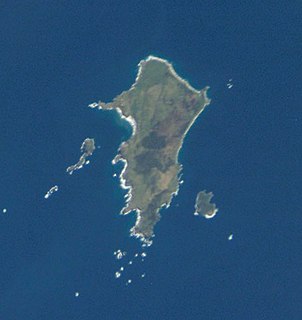
Pitt Island is the second largest island in the Chatham Archipelago, New Zealand. It is called Rangiauria in Māori and Rangiaotea in Moriori.
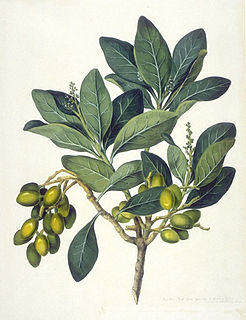
Karaka or New Zealand laurel is an evergreen tree of the family Corynocarpaceae endemic to New Zealand. It is common throughout the North and South Islands to Banks Peninsula (43°45′S) and Okarito (43°20′S), on the Three Kings Islands, on Raoul Island in the Kermadecs, and on the Chatham Islands. It is widespread in coastal habitats, often forming a major component of coastal forest, though it rarely dominates. Most botanists consider it to be native only to the northern half of the North Island, having been planted elsewhere by Māori near former village sites, and subsequently spread by birds. The common name karaka comes from the Māori language, and is also the Māori term for the colour orange, from the colour of the fruit. In the Chatham Islands, it is called kōpī, its name in the Moriori language. It is naturalised and considered invasive in Hawaii.
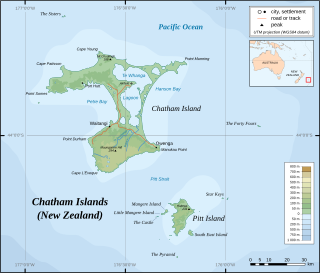
Mangere Island is part of the Chatham Islands archipelago, located about 800 kilometres (500 mi) east of New Zealand's South Island and has an area of 113 hectares. The island lies off the west coast of Pitt Island, 45 kilometres (28 mi) south-east of the main settlement in the Chathams, Waitangi, on Chatham Island.

Hokorereoro, Rangatira, or South East Island is the third largest island in the Chatham Islands archipelago, and covers an area of 218 hectares. It lies 800 kilometres (497 mi) east of New Zealand's South Island off the south-east coast of Pitt Island, 55 kilometres (34 mi) south-east of the main settlement, Waitangi, on Chatham Island.

The Sisters / Rangitatahi is a group of three islands located 16 kilometres (10 mi) north of Cape Pattison, Chatham Island. They are the northernmost members of the Chatham Archipelago, located 800 kilometres (497 mi) east of New Zealand's South Island.

The Star Keys are group of five rocky islets in the Chatham Archipelago, about 12 kilometres (7 mi) east of Pitt Island They are called Motuhope in Moriori and Māori. The archipelago is part of New Zealand, whose South Island lies 800 kilometres (497 mi) to the west.

Little Mangere is a small island of the Chatham Archipelago, just off the western end of Mangere Island, about 4 km west of Pitt Island and 45 kilometres (28 mi) south-east of the town of Waitangi on Chatham Island. The island is called Tapuaenuku in Moriori and Māori, and was formerly called The Fort. The archipelago is part of New Zealand and is located about 800 kilometres (500 mi) to the east of the South Island.

Arborglyphs, dendroglyphs, silvaglyphs or modified cultural trees is the carving of shapes and symbols into the bark of living trees.

Hawkins' rail or the giant Chatham Island rail is an extinct species of flightless rail. It was endemic to the Chatham Islands east of New Zealand. It is known to have existed only on the main islands of Chatham Island and Pitt Island. Hawkins's rail was the largest terrestrial bird native to the Chatham Islands, around 40 centimetres (16 in) tall and weighing about 2 kilograms (4.4 lb). It had a long, downward curving beak. Historic accounts likely referring to the bird by the name Mehonui suggest that it was red-brown in colour, and it has been compared to the weka in ecological habits, using its beak to probe decaying wood for invertebrates. Hawkins's rail likely became extinct due to overhunting by the islands native inhabitants, the Moriori, and the bird is known from skeletal remains found in their kitchen middens.

The Chatham Island pigeon or parea is a bird endemic to the Chatham Islands in New Zealand. Growing to 800g in weight and 55 cm in length, the Chatham Island pigeon is closely related to the kererū or New Zealand pigeon, the only other species in the genus Hemiphaga.
A national reserve in New Zealand is a reserve that has been designated as having national importance under section 16 of the Reserves Act 1977. They are administered by the Department of Conservation.
The Tuku Nature Reserve is a nature reserve on Chatham Island, New Zealand, in the Tuku-a-tamatea (Tuku) River Valley in the south-west of the island. The 1238 hectares of land, largely covered with dense native forest, are owned by the New Zealand government and is managed by its Department of Conservation.
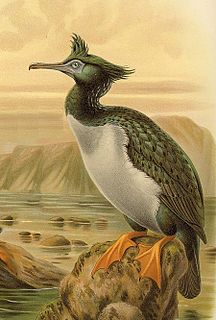
Okawa Point lies at the north-eastern end of Hanson Bay near the easternmost point of the main Chatham Island in the Chatham Islands group of New Zealand. It has been identified as an Important Bird Area by BirdLife International because it supports breeding colonies of the critically endangered Chatham and endangered Pitt shags.

Matarakau Point is a headland on the north coast, and 13 km from the easternmost point, of the main Chatham Island in the Chatham Islands group of New Zealand. It has been identified as an Important Bird Area by BirdLife International because it supports breeding colonies of the critically endangered Chatham and endangered Pitt shags.
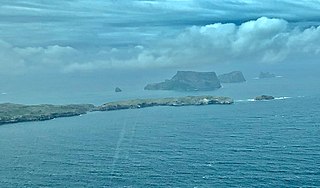
Rabbit Island is a rocky islet lying off Tarawhenua Point on the north-west coast of Pitt Island in the Chatham Islands group of New Zealand. About 300 m long by 200 m across, its highest point is 44 m above sea level. It has been identified as an Important Bird Area by BirdLife International because it supports breeding colonies of the critically endangered Chatham and endangered Pitt shags.
Rhys Morgan Richards is a former New Zealand diplomat and a current historian and ethnographer. He has written extensively on maritime history and Pacific artifacts and art. He has also spoken on these subjects on New Zealand radio and at many conferences and seminars around the world.














